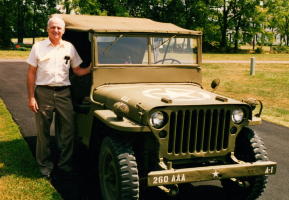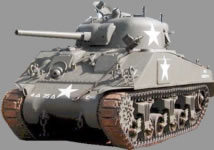|
Get
to know your VMMV staff & vehicles
In
this section we introduce you to the people and armor of the
Virginia Museum of Military Vehicles. We will chat with the
VMMV staff, so that you can get to know the people who "keep
'em running" and work so hard behind the scenes. And also
provide a behind-the-scenes look into the history of individual
vehicles in the VMMV collection. In this, our eighteenth newsletter,
we interview one of VMMV's volunteers, Roland B.
Roland,
Tell us a little about yourself.
I was born in McLean, VA in 1931 and graduated from Fall Church
HS at the age of 15 in 1947- then went into the DC National
Guard for 4 years. In 1951 I was activated into the regular
army for the Korean War and was stationed at Camp Stewart in
Georgia. In 1952 my enlistment was up and I got out and went
to work as a service station manager in McLean. Near the CIA
HQ in Langley there was a military post during the Korean War
to guard against attack on capital that the VA National Guard
(VANG) took over. When the battery commander found out I was
previously in the antiaircraft artillery, he talked me into
joining to train the VANG for 4 years.
How
did you get interested in collecting militaria?
I had two brothers who served in WWII, so I think my strong
interest stemmed from them. One brother in the Army went over
to North Africa in late 1942, fought till the end of that campaign,
shipped to England and went into France after D-Day. He stayed
in the European Theater of Operations and was awarded six combat
stars. I found an old Jeep, brought it home and completely restored
it from the frame up, which I still have today. I've been collecting
WWII stuff ever since then and have what I think is a nice collection.
 |
 |
So
you worked on Quad 50 caliber machine guns while in the Army?
When I first went into the DC National Guard, we were on quad
50 caliber machine guns which were mounted on a halftrack. Then
we trained on 40mm cannons. Next thing I know, I was in Delaware,
firing 90mm cannons over the ocean. Down at Camp Stewart we
also had the 90mm. The VANG had 90s initially but switched over
to the even bigger 120mm cannon….so I got to know all the
AAA from small to large. The 120s had a really big bang…we
had no ear protection, we just opened our mouth. When we fired
them in Delaware, the sand on the beach would jump a foot in
the air simply from the muzzle blast. The quad 50 machine guns
and the 40mm cannon were aimed by eye, but the 90s and 120s
were radar-guided, so I learned a little bit about the impact
of radar while it was still in its infancy.
After
the Army, what was it like being in Northern Virginia with all
the growth?
McLean can't be recognized from the 1940s and I spent 50 years
growing up there. Tyson's Corner was just an intersection of
two dirt roads with a gas station and now look at it.
Rumor
has it that you were the originator of one of VMMV's most cherished
labels….."The Tank Farm." Tell us how that came
about.
One day in the late 1980s when VMMV first opened I met the then-operations
manager and we got to talking. I looked around and noted that
there were no houses around and this was farm country. But instead
of growing crops, as the operations manager noted, they were
re-doing tanks….so I said this is a "Tank Farm"
then. The ops manager laughed, and I went home and told a fellow
volunteer (Larry from Vol. 3 Issue 2) we have a tank farm over
there, which is how it caught on.
What
is your favorite tank of all time?
The Sherman….love at first sight. It was the first tank
I ever got familiar with, climbed up on, over and around. I
also think the German Hetzer is a pretty neat little thing…compact.
Tell
us more about your Jeep.
My Jeep is a 1943 Ford GPW with all the accessories. I bring
it to various shows and parades, particularly around Veterans
Day and Christmas. I've also brought it up for the Battle of
the Bulge re-enactment at Fort Indian Town Gap and it has appeared
in some shows at Virginia Beach. In earlier times when traffic
around here wasn't so bad, I took it all over the area. The
maximum army speed was 35MPH-it is geared too low to go much
beyond 40 MPH.
Ketchup
or Mustard?
Mustard, but I like so many things such as a good T-bone steak
and apples….I love apples. When I was little, we had a
small apple orchard in McLean where I lived and I ate them all
the time, very good with a little salt right off the tree.
|












